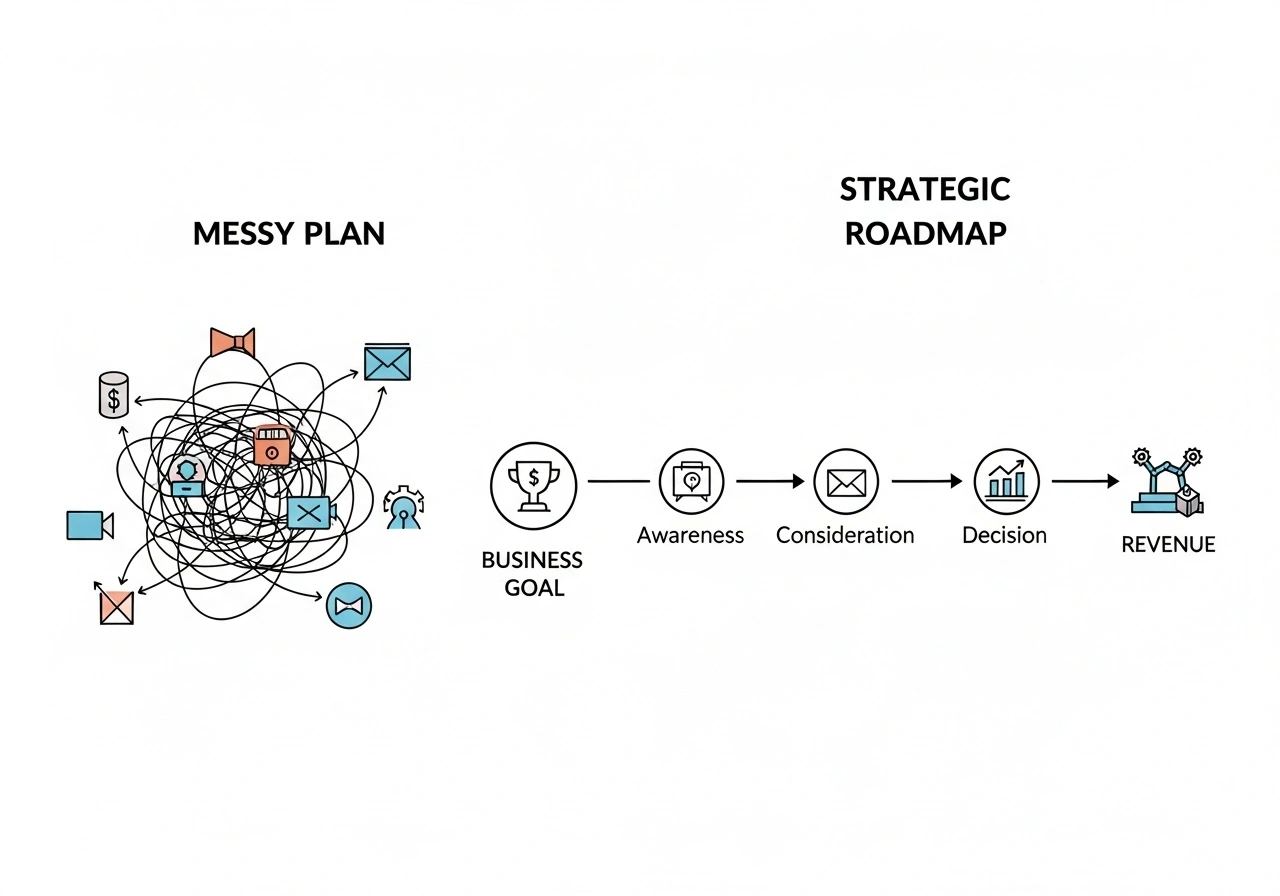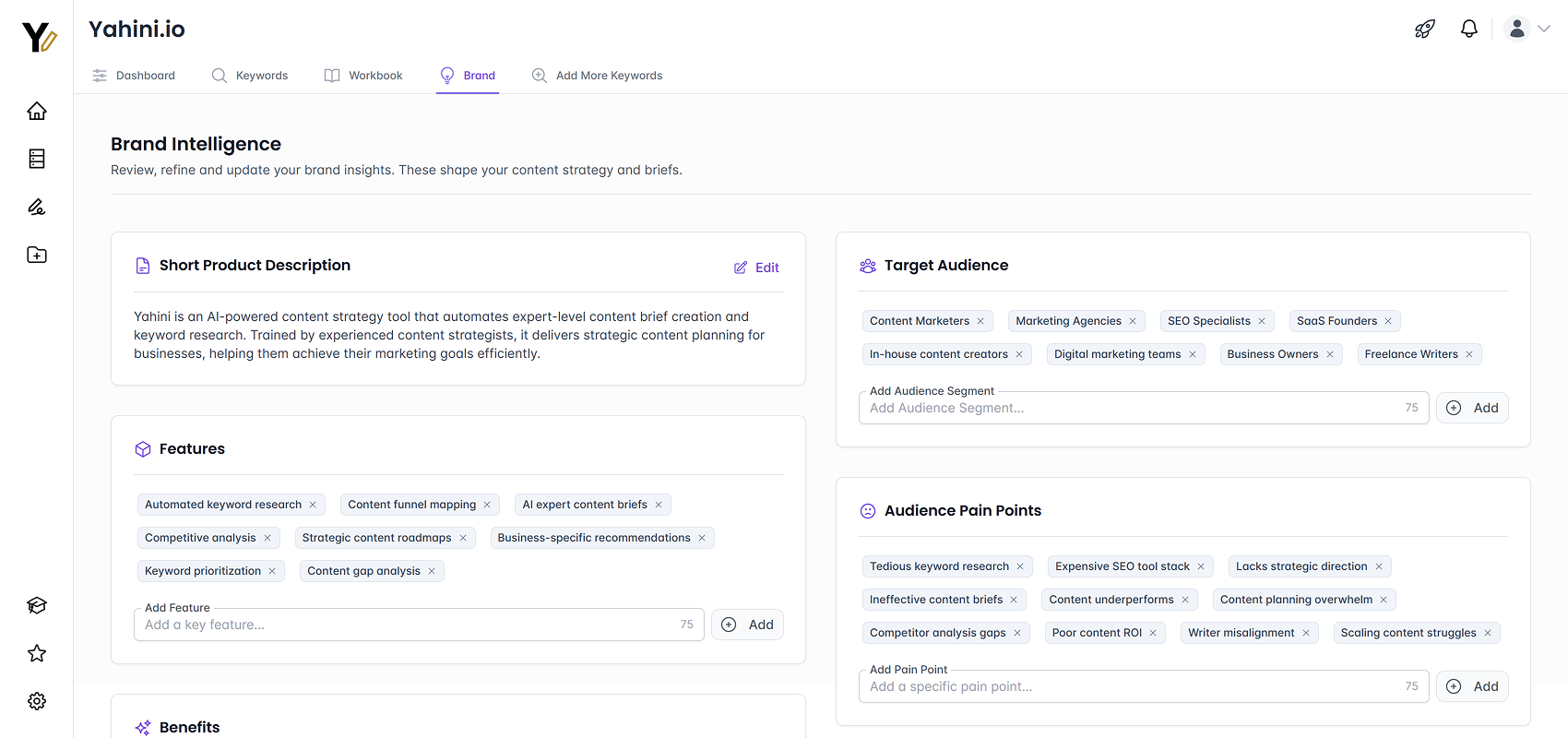
Struggling to Nail Your Content Strategy? You Need This Content Roadmap

Content Marketing Manager
Let’s be real. You know you need a content strategy roadmap. But if your current plan feels more like a messy, color-coded to-do list than a strategic blueprint for growth, you’re in the right place.
We can skip the basic definition, you already know what a roadmap is supposed to be.
The real issue is the costly disconnect that happens when your content activities don't align with actual business results.
You’re publishing, promoting, and pouring hours into creation, but are you moving the needle on revenue?
Without a real strategy, your content marketing is just creating noise.
And you're not alone in this struggle. While the majority of marketers do content marketing, a significant chunk are still flying blind without a documented strategy, wondering why their efforts aren't paying off.
This article is your guide to building a content strategy roadmap that works; one that turns content from a cost center into a revenue driver.
Table of Contents
What a Strategic Content Roadmap Actually Looks Like

An effective content roadmap is so much more than a content calendar.
It's the high-level master plan that connects every blog post, video, and case study (all your content assets) to a specific, measurable business objective. It’s how you turn words on a screen into demo requests, sign-ups, and sales.
A truly strategic roadmap must contain these essential components:
-
Clear Business Objectives: Define what success looks like in measurable terms.
- Example: "Increase qualified demo requests from organic search by 25% in the next six months."
-
Audience Pain Points: Go deeper than generic personas. Map your content directly to the specific problems your audience is trying to solve right now.
- Example: "Pain Point: Our marketing agency struggles with managing content plans for five different clients in separate, chaotic spreadsheets."
-
Funnel Stage Alignment: Assign every single topic to a specific stage in the buyer’s customer journey. This ensures you’re effectively nurturing them through your marketing funnel towards a solution: yours. The goal is to create content for the entire lifecycle, from initial awareness to the final purchase decision.
- Example: A broad topic like "What is content marketing?" is Top of Funnel (TOFU), while a specific "Product X vs. Product Y" comparison is Bottom of Funnel (BOFU).
-
Topic Clusters: Group your content around core pillar topics, which act as your primary content themes. This helps you build topical authority, making it easier for both search engines and your audience to see you as the go-to expert.
- Example: Pillar: "Content Strategy." Clusters: "content roadmap," "keyword research," "content briefing," "content analytics."
-
Content Formats & Channels: Don't just decide what to say, decide how and where to say it for maximum impact.
- Example: Topic: "How to Build a Content Roadmap." Format: "How-to Guide (Blog)." Channels: "Organic Search, LinkedIn, Newsletter."
-
Content Planning: A clear plan for how and when content will be produced, reviewed, and published, making sure all team members are aligned.
How to Build Your Content Roadmap: The Manual Way (And Why It Hampers Effective Content Creation)
So, how do you get all this done?
You can of course, do it manually. In fact, it’s how most team members have been doing it for years. But let's be honest, a lot of teams do it wrong. The good, old “Excel days” are over, and if you’re still using spreadsheets to organize content plans, I recommend you invest in automation tools (like SheetXAI, for example) or build your own automation workflows.
But let’s get into the process.
Step 1: Set Your Goals and KPIs
First, you translate your high-level business objectives into specific content goals and the KPIs to track them. Ideally, this starts with a thorough content audit to understand what content assets you already have and how they're performing.
-
Example Goal: "Reduce customer churn by 5% with better onboarding and educational content."
-
Example KPI: "Increase traffic to the /help section of our website by 40%."
Step 2: Manually Research Keywords and Competitors
This is where the real headache begins.
You begin a manual competitor analysis, fire up multiple SEO tools, export mountains of data into separate CSV files, and then spend hours—or days—trying to de-duplicate the information and sift through thousands of keywords to find a few hidden gems, often missing high-intent long-tail keywords that could drive valuable organic traffic.
Pfew, that was a mouthful!
It's a labor-intensive process of pure data organization.
Step 3: Group Topics and Map to the Funnel
Now comes the hard part.
You have a list of keywords, but what is the user's intent behind each one? You have to manually determine if a searcher is just learning (TOFU), comparing solutions (MOFU), or ready to buy (BOFU).
This is where costly mistakes happen.
For example, a strategist might see the keyword 'how to choose a project management tool' and classify it as TOFU (Top of Funnel), creating a general awareness piece. But the word 'choose' signals a user who is actively comparing options, making it a critical MOFU(Middle of Funnel) keyword.
Getting this wrong means attracting the right person with the wrong message, causing them to bounce instead of convert.
Step 4: Force it All Into a Spreadsheet
The final, cumbersome step: cramming everything into a massive spreadsheet. You create columns for Topic, Primary Keyword, Search Volume, Keyword Difficulty, Funnel Stage, Status, Author, and on and on. This spreadsheet often doubles as a clunky content calendar, making it difficult for team members to collaborate and track both content creation tasks and content operation tasks.
While this might feel organized, it’s a static nightmare. It's nearly impossible to update, manage internal links effectively, collaborate on, or manage at scale—especially if you're an agency juggling multiple clients (or, just to cheat a bit here because I know we’re on the “manual process” side now, but you could use an actual content management system like Relato).
While understanding these manual steps is absolutely essential for any content strategist, it’s clear the process is riddled with inefficiencies that drain time and create opportunities for error.
The core principles are sound, but the execution is broken.
A More Efficient Way: Create a Content Roadmap with Yahini
Or you could use Yahini, the smart, automated way to build a truly strategic content strategy roadmap without the spreadsheet-induced migraines. This approach transforms your content operations, leading to more effective content marketing. Here’s how Yahini directly solves the pains we just covered.
Again, to reiterate:
The enemy isn’t the spreadsheet itself. It’s the manual data wrangling, strategic guesswork, and siloed information.
Step 1: Get Instant Insights with a Website Analysis

Instead of spending hours on manual analysis, Yahini starts by building your unique strategic foundation.
You provide your business context—your URL, key competitors, and audience details.
Yahini gets to work, analyzing this information alongside real-time SERP data to create your custom Brand Intelligence profile. (Think of this as Yahini building a unique playbook for your business. It learns who you are, who you're up against, and what your audience cares about, so every suggestion is tailor-made for you, not based on generic data.)
This automated competitor analysis is the core understanding of your market position that powers everything that comes next. This intelligence is what allows Yahini to automatically deliver a prioritized list of strategic keywords and ensure every content brief is infused with your unique brand context.
It’s the difference between a blank slate and a powerful starting point built exclusively for your business.
Step 2: Find Your Strategic Keywords, Automatically
Forget wrestling with CSVs.
Yahini’s automated AI keyword research analyzes your competitors and filters keywords based on your specific business goals, eliminating the guesswork and surfacing the topics, including profitable long-tail keywords, that will actually drive impact and increase organic traffic.
Step 3: Map Your Entire Funnel in One Click
Remember that subjective, error-prone manual funnel mapping? Yahini automates it.
Our AI models, trained by seasoned content strategists, automatically assign every topic idea to the correct funnel stage (TOFU, MOFU, BOFU). This ensures your roadmap provides a clear, logical customer journey that guides readers from awareness right through to decision and down the sales funnel.
Step 4: Turn Your Roadmap into Actionable Briefs
A roadmap is useless if it doesn't lead to great content. Yahini makes this connection seamless, but it goes far beyond creating generic outlines.
Instead of just describing what’s on the SERP, Yahini delves into why certain content ranks. It analyzes patterns, identifies weaknesses, and pinpoints strategic opportunities, allowing it to generate content briefs that are prescriptive, not just descriptive.
This means Yahini’s briefs don't just tell you 'the top 10 articles have a listicle format.' They incorporate that knowledge into the briefs and give you a unique angle to beat them.

The goal is to give you a unique angle designed to stand out and resonate deeply with your audience.
Each of the expert-trained content briefs is built on a foundation of your unique business context—your website, arguments, and value propositions—and is structured using proven frameworks optimal for its specific funnel stage (TOFU, MOFU, or BOFU).
The detailed content briefs solve the problem of disconnected content for good by providing a clear, actionable plan that turns your roadmap into content that achieves real business outcomes.
Ready to Stop Guessing and Start Strategizing?
A content roadmap is non-negotiable for growth, but the old way of creating one is broken. It’s a flawed approach to content planning that costs you time and money. You can continue down the slow, expensive, and error-prone path of manual spreadsheets, or you can embrace the fast, automated, and strategic approach with Yahini.
The goal is to build a strategic plan that reliably hits your business objectives.
Take the first step toward a smarter content strategy. See how yahini.io turns your website data into a powerful, actionable content roadmap.
Ditch the generic outlines! Sign up now.
1. Need a 24/7 content strategist? See how Yahini can help you craft perfect SEO content briefs.
2. Any questions? I’m happy to help! Just reach out to us!
3. Not ready yet? Learn more about Yahini here.